Upon meeting my client, full detail of DNA's purpose was provided, as well as the extent to which it could be utilised. I was given evidence based on tests suggesting that the application would allow collaboration across the world in a shared, global family tree network, enabling relatives to share information with each other. This would ultimately allow users to more easily associate with their current family members, learn about deceased ancestors that existed centuries ago, and appreciate their heritage much more than before. I was also provided with the message that the client wanted me to implement into the advertisement, which was the concept of family. Specifically, it was most important that I make the audience realise the true beauty and significance of the forming and maintenance of bonds between current family members, as well as of the momentous experience of learning about the lives of past relatives. After discussing the application's purpose and message to the world, the client clearly explained the type of audience that my promotion should aim to appeal towards. Consisting of explorers and seekers of their family history, generally between the ages of twenty and eighty, the audience would be the most important aspect of the service. In terms of brand perception, the client obviously requested that the title of the application be present at some point in the video, in addition to the company name and logo being clearly visible at the end of the advertisement. Additionally, the promotion must plainly state that the application is completely free to use, thereby including the downloading, creating of accounts, and receiving of results. Furthermore, although not entirely necessary, it was suggested that I try to include within the visuals a certain shade of crimson that the company is hoping to make people associate with the application, as it is the main colour of the logo, and is used all throughout the program itself.
Due to being told of the application's high potential of enabling users to learn about past relatives that existed many centuries ago, I wanted my advertisement to capture the visual distinctions of previous time periods, along with the fascination that comes from discovering that one's ancestors can be traced back to such periods. Overall, I knew from the beginning that one of the most appropriate ways of promoting this feature was for my advertisement to feature realistic depictions of individuals from certain eras. Such eras would be portrayed through the clothing, makeup, and possessions of each character. This meant that the advertisement would consist of actors using their appearance to represent one of multiple time periods that had yet to be chosen. I performed basic research on the majority of previous eras set after a certain period that Fruit Bowl Tech told me was too unlikely to trace family trees back to. Afterwards, I narrowed the amount that I would include in my advertisement down to ten, based on general appearance. Once I had a general concept in mind, I produced a basic mood board consisting of online images, to help visualise the characters.
The types of individuals that I had chosen were Ancient Greek, Roman Soldier, Viking Warrior, Renaissance Lady, Tudor Nobleman, Georgian Lady, Victorian Lady, British World War I Soldier, British World War II Soldier, and Modern Man. Satisfied with the idea, I began work on the official planning by creating a storyboard to determine the exact content of the advertisement.
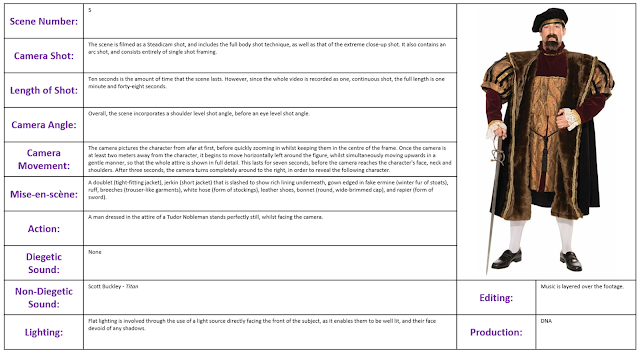
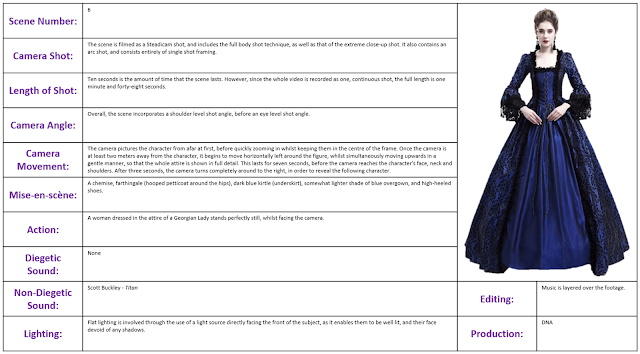
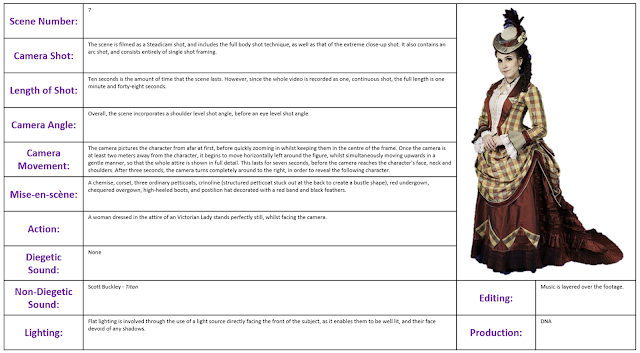
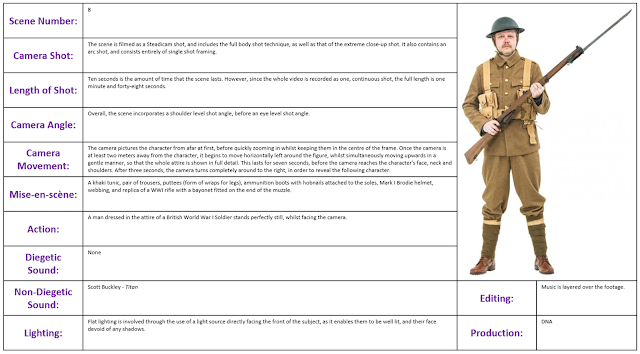

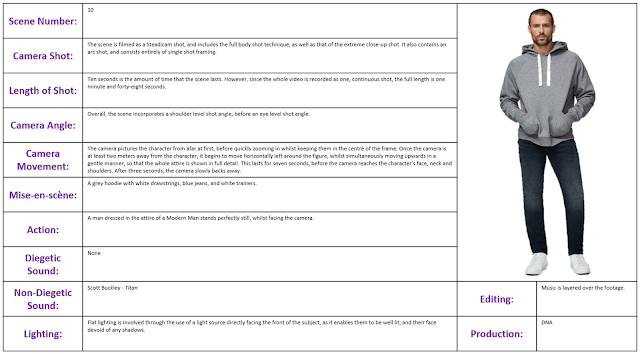

The advertisement would begin by fully presenting the first character: a male civilian from Ancient Greece, dressed in a white chiton (form of tunic) worn underneath a red himation (form of wrap), complete with a pair of leather sandals. Appearing from afar at first, the camera will quickly zoom in, keeping the character in the centre of the frame. Once the camera is at least two meters away from the character, it will begin to move horizontally left around the figure, whilst simultaneously moving upwards in a gentle manner, so that the whole attire is shown in full detail. This will last for seven seconds, before the camera reaches the character's face, neck and shoulders. Their eyes, which will be looking at the camera lens since the beginning of the advertisement, are the main focal point at this time, due to being centered in the frame. After three seconds, the camera will turn completely around to the right, in order to reveal the second character, who will be stood the same distance away as the Ancient Greek originally was.
Stood in place as the new figure, he will be donned in Roman Solider uniform, consisting of a galea (form of helmet), chest armour made of metal strips worn above a red tunic, and caligae (heavy-soled, hobnailed, military sandal boots). He will be wielding a gladius (sword) in his right hand, and a scutum (shield) in his left. The camera shall move in the exact same manner, before turning around to reveal the third character.
As a Viking Warrior, the new individual shall be wearing a brown sort of coat made from faux fur (to represent a real animal pelt), topped with a tunic made of linen, above a pair of woollen trousers and leather boots. The character will also be featured sporting a spangenhelm (form of helmet), and shall be holding a bearded axe in his right hand, as well as a round shield in his left. Once the camera has finished presenting in the same fashion as before, it will turn to exhibit the following historical individual.
In order to capture the likeness of a female civilian from Europe during the period of the Renaissance, the fourth character appears in a chemise (long, white garment resembling a nightdress), underneath a leather corset, mostly covered by a full-length, orange gown. Upon her head sits a conical hennin (form of headdress). The camera will perform its movement, and finish by centering the next character of the advertisement.
For the appearance of a Tudor Nobleman, the next individual will be dressed in a doublet (tight-fitting jacket), topped by a jerkin (short jacket) that is slashed to show rich lining underneath. Worn above this is a gown edged in fake ermine (winter fur of stoats), whilst a ruff is sported around the neck. His legs will be fitted with breeches (trouser-like garments), placed above white hose (form of stockings), accompanied by squared-toed, leather shoes. The top of the head will be covered by a bonnet (round, wide-brimmed cap). To complete the look, the character will be using his right hand to wield a rapier (form of sword). The next individual will be presented through the same use of camerawork.
Following on, the sixth figure - a Georgian Lady - shall be fitted with a chemise, underneath a farthingale (hooped petticoat around the hips) worn to greatly extend and shape the woman's skirts placed over. Atop this will be a dark blue kirtle (underskirt), suited below a somewhat lighter shade of blue overgown, which will be fashioned to allow a front piece of the kirtle to show through in a 'v' shape. Although the skirts will completely cover the figure's legs and feet, she will also wear high-heeled shoes to increase height. Lastly, her hair will be tied back into a loose-fitting bun. Once again, the camera will circle the character to display her thoroughly, before turning to reveal the following figure.
Succeeding the previous individual, the next dresses as a Victorian Lady. Therefore, she will be wearing a chemise, topped with a corset, three ordinary petticoats, and a crinoline (structured petticoat stuck out at the back to create a bustle shape). Above all this, she will sport a red undergown that trails on the floor behind, as well as a chequered overgown that is draped over the front and back of the lady, and ruched up at the sides. Despite her shoes not being seen due to the length of the dress, she will wear high-heeled, leather boots to appear taller. Her hair will be curled, whilst being held high at the back of the head, and pushed over her left shoulder. Atop her head sits a small postilion hat, made with a high crown and narrow brim, decorated with a red band and black feathers. After she has been presented in full detail, the camera will move as it always has done to show the very next individual.
To represent a British World War I Soldier, the following character will be donned in a thick, woolen, khaki uniform consisting of a tunic and a pair of trousers. Many pockets will be sown onto the tunic in specific places, as will a set of brass buttons. Puttees (form of wraps for legs) will be worn around the ankles and calves, above ammunition boots with hobnails attached to the soles. A Mark I Brodie helmet must be placed on his head, and fastened securely using the strap that comes out from either side of the helmet, before being stretched around the chin. He will also wear a webbing for carrying kit around his front, back and shoulders. To finish the look, the character will be using both hands to wield a replica of a WWI rifle with a bayonet fitted on the end of the muzzle. As usual, the camera shall record the soldier, before unveiling the individual that follows.
Being clothed in battledress (form of military uniform adopted by the British Army), the adjacent figure matches the appearance of a British World War II Soldier. The man will sport a short blouse with two pockets, as well as a pair of trousers that features a cargo pocket on the left leg, and is enclosed by webbing anklets. He will also wear a pair of black ammunition boots, along with a webbing for carrying kit around his front, back and shoulders. His head shall be covered by a Mark II Brodie helmet fitted with a chinstrap, and coated with a helmet cover (camouflaged netting). Most of the face will be hidden by a gas mask, and he will will use both hand to hold a replica of a Lee-Enfield rifle. Despite the mask, the camera can still present the character's eyes through the lenses, until it turns to display the next figure.
Ending the line of characters, the tenth and final individual will represent a Modern Man by being dressed in a simple, grey hoodie with white drawstrings, combined with blue jeans and white trainers. This modern look will help the majority of target audience viewers to relate to early on in their DNA journey. When the camera has circled the man, and is facing his eyes, instead of turning to the right, it will slowly back away, keeping the character in the centre of the frame. A male voice can be heard calmly saying 'Discover your past. Navigate your present. Achieve your future.'. The visuals will then fade to reveal the application's name and logo, as well as the web address and company phone number, over a background coloured with the shade of crimson used by the service. At this point, the same voice will say 'For free, join and use DNA today. Thank you.', before the advertisement ends. It is important to remember that from the moment that each character appears onscreen, they will not move, remaining frozen in place as if they are statues. Additionally, for the whole runtime, the background used behind and all around the characters will be the same crimson shade that the company hopes people will associate the service with.
For the organised scheduling of tasks, I created a Gantt chart to plan the dates that each duty should be completed by.
A script was required to give to the voice actor that would later be hired, and so I took the time to produce one.

Since the advertisement is to contain no diegetic sound, music is required to suit the visuals. Without any, the video would play in complete silence until the voice-over plays at the end, making the experience seem uninviting and improper. Therefore, in order for the advertisement to be even more enjoyable as well as impactful, I chose to layer the footage with royalty-free, public domain music in the form of Scott Buckley's Titan: a song that both matches and enhances the monumental experience of discovering past relatives and the periods of which they lived in.
For legal reasons, I printed copies of an official form detailing release of the video itself, to later ensure that all actors hired to star in the video would willingly sign.
Once basic planning for the advertisement had been completed, I contacted the client via email, sending a copy of my work, in order to receive feedback. Upon reviewing my ideas and way of executing them, the client approved, and granted me further permission to begin creating the promotion on camera.
Due to the advertisement's nature of being intended for television broadcast, it obviously needed to be filmed using highly professional camera and lighting equipment. In order to utilise such resources without spending ridiculous amounts of money on the purchasing of said equipment, I hired what was required from a company known as Cameraworks. The hardware consisted of a camera, lens, gimbal, and four LED lights. Although the equipment was only needed for three days, I decided to hire all for a week each, since doing so for the first three pieces equaled the same price as hiring them for three days at a time. For example, instead of hiring the camera for three days at the total price of £480 - due to usage for each day costing £160 - I chose the option that meant paying £480 for each week, as I would be spending the same amount whilst receiving a longer time of usage.
For the cinematography that I had in mind, I would need to make efficient use of a green screen studio. My search results informed me of Studio 1 at Camberwell Film Studios located in London. Not only did this establishment appear highly impressive to me due to being 7.5 metres wide - which I needed to take advantage of - it also seemed suitable because of what was included in the price. A production office, wardrobe and makeup room, drive-in for cars, on-site parking, Wi-Fi, shared use of the canteen, and basic catering, are all covered in addition to the studio. I decided to pay three lots of £725, equaling £2175 in total, as three days was the estimated amount of time that the filming for the advertisement would be finished by.
As is the case for all film and television productions, all crew members hired to operate in the rented studio within working hours, must be well fed and watered. While Camberwell Film Studios do not offer catering directly, they are local to a café situated very close the establishment that would serve as the work area for at least three days. Each of the seventeen crew members would be given £20, equaling £340 overall, to spend on food from the café, which could be ordered through telephone call, before being collected and eaten in the canteen provided by the studio. The café was also suitable due to its likeliness to please everyone, including vegetarians, through its wide variety of menu items such as breakfasts, ciabattas, paninis, wraps, sandwiches, burgers, jacket potatoes, salads, various main meals, various desserts, tea, coffee, soft drinks, milkshakes, and smoothies.
Four groups of people were required to effectively produce the advertisement. These were actors, hair and makeup artists, equipment technicians, and property masters. All ten actors were hired from Backstage, and agreed to be paid £300 for each of the three days spent filming. Two makeup artists were employed from Brushstroke, both accepting payment of £250 per day. In addition, a couple of equipment technicians working for Kennington Film Studios were recruited, with one being paid £350 each day for managing camera equipment, and the other being paid the same amount for management of lighting. Lastly, two property masters listed on Source Media TV were also commissioned, each for a price of £200 per day, with one being responsible for acquiring the props needed, and the other tasked with overseeing them.
After browsing Voices.com for a professional voice actor, I encountered one who I felt truly captured the wonder behind the phenomenon of tracing family bloodlines to discover the lives of past relatives. Thus, I decided to hire him by sending a copy of the script, before he agreed to be paid £40 to speak for a definitive eight seconds.
PeoplePerHour provided me with a range of qualified editors suitable for creating the advertisement's closing scene. Finding a freelancer who had produced similar work to what I had in mind, I hired him for a very reasonable price of £20 per hour. This meant that I only needed to pay him one amount due to knowing that what I was asking for would take little time to develop.
In order for the voice actor to record their lines efficaciously, I needed to hire a recording studio so that I would be granted access to audio equipment that enabled the voice-over to achieve a high level of authenticity and trustworthiness. Impressed by Studio 3 at Voiceover Soho in London, I paid £99 for its Wild Voice-Over Recording option. Since the overall price was £99 per hour, I thought it wise to only pay for one hour, since only eighteen words were required to be recorded.
Perhaps the most important feature of the advertisement was the clothing that the actors would be dressed in, as these would not only make such individuals appear very different and rather eccentric from the people of today, but would enable the audience to determine the periods from each character originated. After spending a large amount of time searching online, I finally managed to assemble full-body outfits for the actors to wear. Websites such as Medieval Shop, Guntrader, Etsy, Wish, eBay, and Amazon.com provided me with items that I required to craft the centrepiece of the advertisement. This resulted in spending an enormous total of £5346, which although extremely costly, was also highly fruitful.
Ultimately, the official cost of the production of the advertisement was £24370.
At the very end of development, I had a result that I was overly satisfied with, which I therefore sent to my client. After a few days, I was invited to another meeting to hear official feedback, as well as discuss how the advertisement would be presented to the public. Overall, my client was exceedingly pleased with how the promotion had developed. In terms of concerns, the client did inform me that they would have preferred the cost to significantly lower. Nevertheless, they were thrilled with the result, and believed that with the correct presentation, they would be able to earn back the same amount of all money spent, as well as receive plenty more in a reasonably short time.















